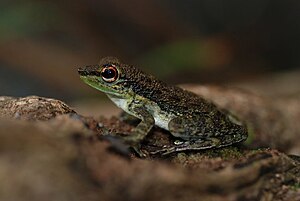Winker frogs
| Winker frogs | ||||||||||||
|---|---|---|---|---|---|---|---|---|---|---|---|---|

Staurois natator |
||||||||||||
| Systematics | ||||||||||||
|
||||||||||||
| Scientific name | ||||||||||||
| Staurois | ||||||||||||
| Cope , 1865 |
The winker frogs ( Staurois , from Greek stauros = cross, pole) are a genus of real frogs from Southeast Asia and the Philippines .
features
The species that occur on Borneo and on the island of Palawan , which belongs to the Philippines , have black spots on their light backs. The species on the other Philippine islands have a predominantly dark back color with light spots on them.
distribution
The genus spread from Borneo via Palawan to the southern Philippines . The genus does not exist in the north of the Philippines. She could have lived on Borneo as early as 90 to 60 million years ago. Opportunities to spread to what is now the Philippines arose 15 and 10 million years ago in the Miocene when land bridges existed between the islands . A distribution in two waves also corresponds to the radiation of other genera in Southeast Asia.
The species of winker frogs live in clear, rocky flowing waters of the tropical rainforests of South Asia and the Philippines. The rushing streams and waterfalls in the mountains have contributed to the fact that these frogs have developed other means of communication in addition to the noises produced by sound bubbles.
behavior
It is characteristic of the winker frogs that they can communicate by waving their hind legs. They also have striking colors on the webbed toes. This is said to have resulted from the high level of noise in the vicinity of waterfalls and rapidly flowing water, which makes communication through sounds very difficult.
Danger
The species Staurois natator is on the Red List of Threatened Species . Although there is not yet sufficient data due to the fact that the species Staurois parvus was only separated from the Staurois tuberilinguis species complex in 2007 , this species was included in the Red List because it is only known from two smaller areas and its habitat is threatened by clearing the rainforest is.
In December 2011 it was announced that the zoological offspring of two species of Staurois had succeeded for the first time in the Schönbrunn Zoo .
species
There are six types :
- Staurois guttatus (Günther 1858), black-spotted winker frog, Borneo
- Staurois latopalmatus (Boulenger, 1887) endemic to Borneo ( Sarawak , Sabah , Brunei and Kalimantan )
- Staurois natator (Günther 1858), ie sense according to Arifin and others, Mindanao (Philippines)
- Staurois nubilus (Mocquard 1890), rebuilt by Arifin and others, Palawan (Philippines)
- Staurois parvus Inger & Haile, 1959, rebuilt by Matsui and others, Borneo, Brunei
- Staurois tuberilinguis Boulenger, 1918, ie p. After the spin-off of S. parvus , Borneo, the Malay states of Sabah and Sarawak
Individual evidence
- ↑ a b c d Umiaela Arifin, Djoko T. Iskandar, David P. Bickford, Rafe M. Brown , Rudolf Meier, Sujahata Marayan Kutty: Phylogenetic relationships within the genus Staurois (Anura, Ranidae) based on 16S rRNA sequences . In: Zootaxa. 2744, 2011, pp. 39-52. Abstract (PDF, English; 23 kB)
- ^ JJ Wiens, J. Sukumaran, RA Pyron, RM Brown: Evolutionary and biogeographic origins of high tropical diversity in old world frogs (Ranidae). In: evolution. 63, 2009, 5, pp. 1217-1231.
- ↑ a b Winker frogs tadpole as a sensation in Schönbrunn , accessed on December 19, 2011.
- ^ Zoo directors magazine
- ↑ Arvin Diesmos, Angel Alcala, Rafe Brown, Leticia Afuang, Genevieve Gee, Robert Inger, Robert Stuebing, Indraneil Das, Paul Yambun, Maklarin Lakim: Staurois natator. In: IUCN 2011, IUCN Red List of Threatened Species, Version 2011.2, accessed January 3, 2012
- ↑ a b c Masafumi Matsui, Maryati Mohamed, Tomohiko Shimada, Ahmad Sudin: Resurrection of Staurois parvus from S. tuberilinguis from Borneo (Amphibia, Ranidae). In: Zoological Science. 24, 1, pp. 101-106, 2007 doi : 10.2108 / zsj.24.101
- ↑ Simon Stuart: Staurois parvus. In: IUCN 2011, IUCN Red List of Threatened Species, Version 2011.2, accessed January 3, 2012
Web links
- Darrel R. Frost: Staurois Cope, 1865 , Amphibian Species of the World: an Online Reference. Version 6.0. American Museum of Natural History, 1999-2015, accessed August 10, 2015